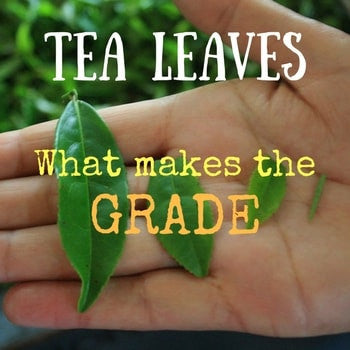
Different Grading Systems, Makes It Complicated
Understanding how tea is graded is quite confusing. All tea is graded based on the size of their leaves. Most people have heard of the term Orange Pekoe or OP. Many tea drinkers think this is a style of black tea, but it is actually a is a term that is widely used in the tea industry to describe the size of the leaf tea.
OP is the most famous tea grading system and this type of grading is popular in the tea growing countries that were former English colonies, like India, Africa etc.
In Japan and China they use a different system entirely and we will discuss this a little later on.
The OP system typically refers to the black teas which were primarily made for the European and American markets, but it is also now used for green teas and other tea styles and is commonly seen on tea bag packaging.
The Orange Pekoe system essentially focuses on the leaf sizes and appearance. Another typical grade is FOP – Flowery Orange Pekoe which is higher quality leaf tea. The lesser OP is BOP or Broken Orange Pekoe. BOP is reserved for faster steeping teas which are common in tea bag tea. Higher grades include Golden Flowery Orange Pekoe (GFOP), Tippy Golden Flowery Orange Pekoe (TGFOP) and Finest Tippy Golden Flowery Orange Pekoe (FTGFOP). Tippy Golden means that within the full leaves there is a higher amount of young buds or tips which indicates a better batch of tea leaves. For the average tea drinker, the short hand rule is the longer the abbreviation, the higher the quality, except for BOP which is less.
Grading of tea leaves by size is problematic because the grades are not worldwide standards and the grades primarily describe the leaf appearance.
Asian Grading Systems
Besides the western OP system of grading of tea leaves, there are the Chinese and Japanese grading systems. Chinese grading is done by numbering, where first is the highest possible grade and it goes down from there. Once again, this is in regards to the shape and style of the leaf and it has nothing to do with the flavor.
Japan has its own unique grading system where teas are not graded based on their leaf size. Most of their teas are blended together in the final phase of the production and many different lots with different sizes are mixed in order to reach cup consistency.
Does Leaf Sizes Equal Better Taste?
Yes and No. The thing to remember is that while Tippy Golden is better than OP, grading of tea leaves is not the only factor to tea quality. Tea leaves alone do not dictate taste, but rather think of these leaves as the raw ingredients. Another huge factor is terroir. Location, climate and methods of cultivation strongly determine the quality of the tea leaves. That it is why Darjelling tea fetches high prices even for its lower grade teas.
Think of the leaves as the raw materials and quality raw materials are needed to make a great final product. Much of the flavor of tea you enjoy comes from the skilled tea makers who takes the raw ingredients (tea leaves) and through the art of their preparation creates a loose leaf tea with its subtle and complex flavors.
Conclusion
Grading of tea leaves is often problematic because the grades are not standardized throughout the world. Another important thing to remember is that the grades serve to describe the leaf appearance only. Tea leaves are the raw materials and they are not the final product. Choosing the best tea leaves is very important, but the skill of the tea maker is crucial for producing a great tea. I would argue that this is the most important part because an unskilled tea maker can make lousy tea even with the best tea leaves.
And for you the tea drinker, the taste of loose tea you drink is what matters the most.
In our shop we take the complexity of all this out. We choose great tasting teas and we offer in store hot samples to try out. Every order gets you free samples to try at home because we know that in the end the taste of the tea is the most important thing.
For this blog post we resurrected a Green Tea Sampler for $10. Try 6 types of Green Tea. Free Shipping too. Happy sipping.
